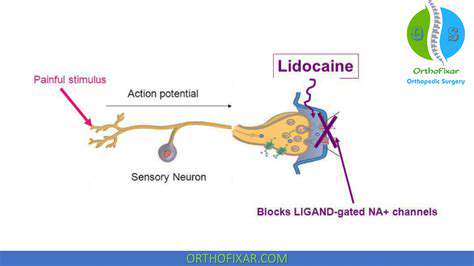The Mechanism of Lidocaine Infusions

Lidocaine's Local Anesthetic Action
Lidocaine, a commonly used local anesthetic, works by blocking sodium channels in nerve cell membranes. This blockade prevents the propagation of nerve impulses, effectively numbing the affected area. This process is crucial for pain relief in various medical procedures. The precise mechanism involves lidocaine's interaction with the voltage-gated sodium channels, preventing the influx of sodium ions, which are essential for the generation and transmission of nerve signals.
Understanding the specific interactions between lidocaine and sodium channels is vital for optimizing its use and minimizing potential side effects. This knowledge also allows medical professionals to tailor treatment plans based on individual patient needs and conditions.
Pharmacokinetics of Lidocaine Infusion
The pharmacokinetics of lidocaine infusion are complex, encompassing absorption, distribution, metabolism, and excretion. Rapid absorption from the injection site is crucial for immediate onset of action, but this process can vary depending on factors like the route of administration and the patient's physiological state. Understanding the rate of absorption allows clinicians to predict the duration of the analgesic effect.
Once absorbed, lidocaine distributes throughout the body, affecting various tissues and organs. The extent of distribution is influenced by factors like blood flow and tissue perfusion. Furthermore, the body's ability to metabolize and eliminate lidocaine plays a significant role in determining the duration and intensity of the anesthetic effect.
Factors Affecting Lidocaine Infusion Rate
Several factors can influence the ideal lidocaine infusion rate, including the patient's weight, age, and underlying health conditions. Individual variations in metabolism and renal function can significantly impact lidocaine clearance. Therefore, clinicians must carefully monitor patients receiving lidocaine infusions to maintain safe and effective treatment levels.
Monitoring vital signs such as heart rate, blood pressure, and respiratory rate is essential during and after the infusion to detect potential complications. Adjustments to the infusion rate may be necessary based on the patient's response and observed clinical parameters. Careful consideration of these factors minimizes the risk of adverse effects.
Potential Complications of Lidocaine Infusion
While generally safe, lidocaine infusion carries potential complications, including cardiovascular and neurological effects. These complications are often dose-dependent and require close monitoring. Overdosing can lead to serious cardiac arrhythmias and seizures.
Careful monitoring of vital signs, including electrocardiogram (ECG) readings, is crucial to promptly identify and address any potential adverse effects. Clinicians must be prepared to intervene effectively if complications arise during or after the infusion.
Dosage Considerations for Lidocaine Infusion
Determining the appropriate lidocaine infusion dosage is critical for achieving effective analgesia while minimizing the risk of toxicity. The dosage must be tailored to the individual patient, considering factors such as their weight, age, and underlying medical conditions. Individual responses to lidocaine can vary, requiring careful monitoring of the patient's clinical status.
Precise calculation of the infusion rate based on the patient's weight, age, and renal function is essential. Failure to properly consider these factors can lead to serious complications.
Clinical Applications of Lidocaine Infusion
Lidocaine infusions find diverse applications in various medical specialties. It is commonly used for regional anesthesia, pain management in various conditions, and as an adjunct in cardiac procedures. Understanding the diverse applications is crucial for optimal clinical use.
The choice of lidocaine infusion for a specific procedure depends on several factors, including the desired duration of analgesia, the patient's overall health, and the specific procedure being performed. Careful consideration of these factors is paramount to achieving the best clinical outcomes.
The Role of Lidocaine in Intractable Headache Management

The Mechanism of Action
Lidocaine, a widely used local anesthetic, exerts its effect by inhibiting the voltage-gated sodium channels in nerve cells. This blockade prevents the propagation of action potentials, effectively numbing the affected area. The specific interaction of lidocaine with these channels is crucial for its analgesic properties, and variations in this interaction can lead to differences in its effectiveness and potential side effects. Understanding the precise mechanism is essential for optimizing its use in various clinical settings.
The process involves lidocaine binding to the sodium channel's pore, preventing the influx of sodium ions. This interruption of the depolarization process is fundamental to the anesthetic effect. Consequently, nerve impulses are blocked, and the transmission of pain signals is significantly reduced or eliminated. This detailed understanding of the mechanism allows clinicians to tailor lidocaine administration to achieve optimal pain relief while minimizing potential complications.
Clinical Applications in Intractable Pain
In cases of intractable pain, where conventional therapies fail to provide adequate relief, lidocaine can be a valuable adjunct or even a primary treatment option. Its ability to effectively block pain signals makes it a viable candidate for managing chronic neuropathic pain, often associated with conditions like diabetes or nerve damage. The administration route can vary depending on the specific location and type of pain, ranging from topical applications to nerve blocks and even intrathecal injections.
Lidocaine's role in managing acute or chronic pain conditions is multifaceted and warrants careful consideration by healthcare providers. Its use in combination with other analgesics can enhance pain control and reduce the need for opioid medications, contributing to a more holistic approach to pain management. Precise dosage and administration techniques are paramount to achieving the desired outcome while mitigating potential risks. Furthermore, the potential for local toxicity must be carefully assessed and managed.
Intractable pain conditions often necessitate a multidisciplinary approach, and the inclusion of lidocaine can play a pivotal role in this strategy. The careful selection of lidocaine formulations and administration methods can significantly impact patient outcomes and improve quality of life.
Considerations and Potential Side Effects
While lidocaine is generally well-tolerated, potential side effects exist, ranging from mild to severe. These can include local reactions at the injection site, such as irritation or swelling, and more systemic effects like dizziness, confusion, and seizures. The severity of these side effects is often correlated with the concentration and volume of lidocaine administered. It is crucial for healthcare professionals to carefully assess patient factors, such as pre-existing medical conditions, and adjust the dosage accordingly to minimize the risk of adverse events.
Careful monitoring of the patient during and after lidocaine administration is essential. Recognizing and promptly addressing any adverse reactions is paramount to ensuring patient safety. The possibility of drug interactions with other medications should also be considered, and patients with a history of hypersensitivity to local anesthetics should be treated with caution. Proper patient education and informed consent are integral components of safe lidocaine administration.
Considerations and Potential Side Effects
Potential Cardiovascular Effects
Lidocaine infusions, while effective for intractable headaches, carry potential cardiovascular risks. These include bradycardia (a slow heart rate), hypotension (low blood pressure), and even cardiac arrest in extreme cases. Careful monitoring of vital signs, including heart rate and blood pressure, is crucial throughout the infusion to promptly identify and address any adverse effects. The dosage and rate of administration must be closely managed by a healthcare professional experienced with lidocaine infusions.
Renal and Hepatic Considerations
Lidocaine is primarily metabolized by the liver, and its excretion occurs through the kidneys. Patients with pre-existing kidney or liver dysfunction may require adjusted dosages or monitoring strategies to prevent potential accumulation of the drug in the body. It's vital to assess the patient's baseline renal and hepatic function prior to initiating lidocaine infusions and to monitor these functions closely throughout the treatment process. This proactive monitoring helps to minimize the risk of toxicity.
Drug Interactions
Lidocaine can interact with other medications, potentially leading to unpredictable effects. For instance, concomitant use with certain antiarrhythmics, antidepressants, or other medications metabolized by the liver or kidneys could increase the risk of toxicity. A thorough medication history is crucial for identifying potential interactions, and the healthcare provider should carefully review all medications the patient is currently taking before starting the infusion.
Allergic Reactions
While relatively rare, allergic reactions to lidocaine are possible. Symptoms can range from mild skin rashes to more severe reactions like anaphylaxis. Prior to initiating the infusion, it is essential to carefully assess the patient's medical history, including any known allergies. If any allergy to lidocaine or other local anesthetics is present, alternative treatment options should be considered. Close monitoring for allergic reactions is paramount during the infusion.
Infection Risk and Prevention
Intravenous infusions, like lidocaine infusions, carry a risk of infection at the insertion site. Strict adherence to aseptic technique during the infusion process is vital to minimize this risk. This includes using sterile equipment and solutions, maintaining proper hand hygiene, and ensuring the integrity of the insertion site. Regular monitoring of the insertion site for signs of infection is essential throughout the treatment period. Prompt intervention to address any signs of infection is crucial to prevent complications.
Patient Education and Informed Consent
Comprehensive patient education about the potential benefits and risks of lidocaine infusions for intractable headaches is essential. Patients need to understand the importance of closely monitoring their symptoms and reporting any unusual side effects to the healthcare team immediately. Obtaining informed consent from the patient, after thoroughly discussing all potential complications and benefits, is crucial. This ensures that the patient understands the treatment, its associated risks, and is comfortable proceeding with the infusion.